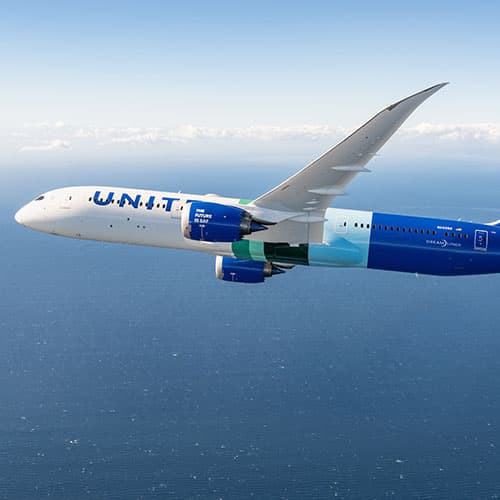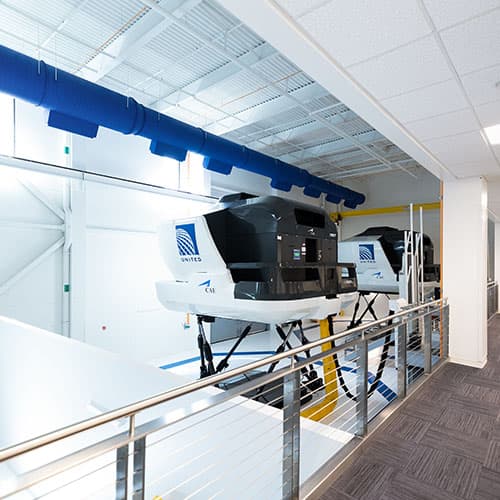
We are continuously identifying opportunities to enhance our customer experience which includes improving sustainability efforts both on board our aircraft and in our clubs and lounges.

In 2024, we prioritized identifying weight reduction opportunities that would allow us to save fuel and therefore reduce emissions from our aircraft. In August 2024, United announced its intention to discontinue the publication of its monthly inflight magazine, Hemispheres, with September 2024 being the final printed edition. After more than 30 years the magazine transitioned to a new, digital format which embraces innovation and technology, and aligns with broader industry trends. The digitization of Hemispheres removed, on average, 79 pounds per aircraft and contributed to emissions savings of roughly 3,000 MT CO2e in 2024 between the months of October and December. This would account for an annual emissions savings of roughly 12,000 MT CO2e. This change was also carried out in our clubs and lounges, further reducing the use of paper and other single-use materials needed to make the magazine.

We also reviewed opportunities to remove single use plastics on board our aircraft. In October, United replaced its economy for-purchase wine, served in mini plastic bottles, with canned wine options. Last year, United served more than 20 million glasses of wine system-wide, and more than 3.2 million glasses of wine were served in domestic economy alone. This transition eliminates the use of an estimated 4.7 million single-use plastic bottles per year on board United flights.

In early 2024, United launched our first reusable cup and mug pilot program at our club located in the Raleigh-Durham International Airport. Based on its success, we expanded the number of pilot programs, including LaGuardia, Phoenix Sky Harbor International, Hartsfield-Jackson Atlanta International, Boston Logan International, Cleveland Hopkins International, Dallas Fort-Worth International, Los Angeles International, Louis Armstrong New Orleans International and San Diego International Airports.
Exploring recycling and waste minimization
United seeks to divert waste and increase recycling across our operations. In 2023, United collaborated with the Port Authority of New York and New Jersey to implement a food waste recycling pilot program at the United Club℠ and terminal concessionaires. In 2024, this resulted in approximately 120 tons of organic waste being diverted from landfills.
In 2024, United launched an additional pilot program at IAH in Houston to collect organics from the kitchens for United Club locations in Terminal C. United partnered with Moonshot, a local composting company. Moonshot collects and composts United’s food waste from clubs, which is ultimately turned into nutrient-rich soil that can improve soil health, decrease erosion and conserve water. In 2024, United collected more than 5,000 lbs. of organic material for composting at IAH.
Educating and empowering our travelers
United continues to educate and empower our travelers about flight related carbon emissions, the benefits of our United Airlines Ventures Sustainable Flight FundSM and SAF.

In 2023, United introduced two customer measures to educate about GHG emissions. First, it became the first U.S. airline to show customers the estimated emissions when booking their travel, empowering sustainability-conscious travelers to choose flights with lower carbon emissions. United also provided its customers the opportunity to directly contribute between $1.00 - $7.00 toward United’s Sustainable Flight Account, which is allocated by United towards SAF procurement. This initiative helps to bolster the demand signal for SAF, while allowing our customers to have a direct role in helping us achieve our future sustainability goals. Notably since the contribution was enabled in 2023, customers have contributed more than $800,000 across 264,000 ticket purchases.

An NFL First: 49ers and United Airlines Launch SAF Pilot Project to Reduce Carbon Emissions from Air Travel
The San Francisco 49ers became the first NFL team to purchase SAF as an initial step towards addressing carbon emissions concerns by purchasing enough SAF to cover game related flying on Sunday, September 22, 2024 on United.
Increasing electrification of equipment on the ground
As of December 2024, more than 38% of United’s motorized mobile ground support equipment (GSE) fleet was electric, indicating a significant step towards electrification in both hubs and line stations. Notably, in our hubs alone, nearly half of our entire equipment has been electrified.
Total number of new electric GSE introduced to United GSE fleet each year

This is our total number of new electric GSE introduced to the United GSE fleet each year, from where we are in 2024 to where we were in 2021, represented in a horizontal bar chart with green bars.
- 2021: 133 GSE units
- 2022: 318 GSE units
- 2023: 539 GSE units
- 2024: 970 GSE units
In addition, United completed electric capacity studies and electrification roadmaps in 2024 to identify high priority locations to focus on the transition from traditional fossil fuel GSE to eGSE along with charger infrastructure. United also received over $1 million in grant funding in 2024 to help procure 12 electric mobile ground power units (eGPUs).
Certifying clubs and maintenance facilities to LEED
United currently operates several Leadership in Energy and Environmental Design (LEED) certified spaces including the United LAX Technical Operations Center (LEED Gold), Willis Tower Corporate Support Center Floor 4 & 5 Amenity Space (LEED Silver), the United Club at SFO (LEED Gold), and SFO United Airlines Flight Operations Center (LEED Silver). In 2024, we achieved LEED Silver Certifications for the United Club locations at EWR in Concourses A & C, the United Club locations at DEN in Terminals A & B, and for the 50,000 sq. ft Building H located at the United Denver Flight Training Center.

United Denver Flight Training Center Building H
The United Flight Training Center is the world’s largest airline-owned flight training center with 24/7 operations and the ability to train upwards of 800 pilots at any one time. In anticipation of United hiring 10,000 pilots by 2030, United expanded the campus with the construction of Building H, completed in 2024. The addition of Building H increases the United Flight Training Center capability to house a total of 52 full-motion aircraft simulators and 34 fixed aircraft training devices. Building H achieved LEED Silver certification and houses United’s first on-site photovoltaic (PV) system.
Reducing our noise footprint
United is actively engaged in reducing aircraft noise and fostering community engagement through participation in Airport Community Noise Roundtables and Fly Quiet Programs at key airports including LAX, SFO, ORD, LHR and more. In recognition of our efforts, United was honored with a Gold Award for operational excellence at LAX among large airlines with more than 100 daily operations in 2023. Our commitment to environmental stewardship is further evidenced by our top rankings in LHR’s Fly Quiet and Green Program and our leading position in the PANYNJ Fly Quiet Program for both EWR and LGA.
Our approach to noise reduction is multifaceted, encompassing the use of preferred runways, deployment of quieter aircraft and proactive community engagement. We have achieved significant milestones, such as the completion of the required navigation performance, authorization required procedures installation and pilot training for our Airbus A319/A320 fleet, enabling near idle power approaches at numerous U.S. airports. Additionally, our pilots undergo a rigorous noise abatement training program.
United voluntarily retrofit its entire fleet of 179 A319/320 Airbus aircraft with vortex generators to eliminate the distinctive whistling noise on older models. Collaborating with the FAA, United is also a partner in the Airspace Modernization Program, which aims to reduce the need for significant engine power at lower altitudes, further mitigating noise impact.
